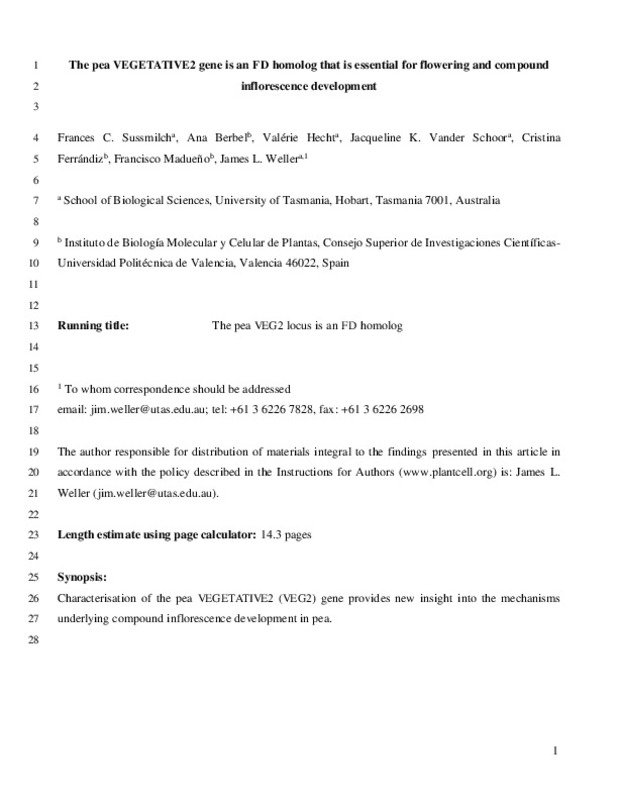JavaScript is disabled for your browser. Some features of this site may not work without it.
Buscar en RiuNet
Listar
Mi cuenta
Estadísticas
Ayuda RiuNet
Admin. UPV
Pea VEGETATIVE2 Is an FD Homolog That Is Essential for Flowering and Compound Inflorescence Development
Mostrar el registro sencillo del ítem
Ficheros en el ítem
| dc.contributor.author | Sussmilch, FC
|
es_ES |
| dc.contributor.author | Berbel Tornero, Ana
|
es_ES |
| dc.contributor.author | Hecht, V
|
es_ES |
| dc.contributor.author | Vander, JK
|
es_ES |
| dc.contributor.author | Ferrandiz Maestre, Cristina
|
es_ES |
| dc.contributor.author | Madueño Albi, Francisco
|
es_ES |
| dc.contributor.author | Weller, JL
|
es_ES |
| dc.date.accessioned | 2017-06-21T11:15:29Z | |
| dc.date.available | 2017-06-21T11:15:29Z | |
| dc.date.issued | 2015-04 | |
| dc.identifier.issn | 1040-4651 | |
| dc.identifier.uri | http://hdl.handle.net/10251/83361 | |
| dc.description.abstract | [EN] As knowledge of the gene networks regulating inflorescence development in Arabidopsis thaliana improves, the current challenge is to characterize this system in different groups of crop species with different inflorescence architecture. Pea (Pisum sativum) has served as a model for development of the compound raceme, characteristic of many legume species, and in this study, we characterize the pea VEGETATIVE2 (VEG2) locus, showing that it is critical for regulation of flowering and inflorescence development and identifying it as a homolog of the bZIP transcription factor FD. Through detailed phenotypic characterizations of veg2 mutants, expression analyses, and the use of protein-protein interaction assays, we find that VEG2 has important roles during each stage of development of the pea compound inflorescence. Our results suggest that VEG2 acts in conjunction with multiple FLOWERING LOCUS T (FT) proteins to regulate expression of downstream target genes, including TERMINAL FLOWER1, LEAFY, and MADS box homologs, and to facilitate cross-regulation within the FT gene family. These findings further extend our understanding of the mechanisms underlying compound inflorescence development in pea and may have wider implications for future manipulation of inflorescence architecture in related legume crop species. | es_ES |
| dc.description.sponsorship | We thank Ian Cummings, Tracey Winterbottom, and Michelle Lang for help with plant husbandry and Ian Murfet for providing seed of the original veg2-1 and veg2-2 mutant lines. We also thank Alejandro Ferrando for kindly sharing pYFPN43 and pYFPC43 vectors, and YFN-AKIN10 and YFC-AKIN beta 2 constructs, and Julie Hofer for sharing unpublished primer sequences for isolation of the FENR1 marker gene. We acknowledge the use of facilities administered by the University of Tasmania Central Science Laboratory. This work was supported by the Australian Research Council (J.L.W.) and the Spanish Ministerio de Ciencia e Innovacion (F.M.). | en_EN |
| dc.language | Inglés | es_ES |
| dc.publisher | American Society of Plant Biologists | es_ES |
| dc.relation.ispartof | Plant Cell | es_ES |
| dc.rights | Reserva de todos los derechos | es_ES |
| dc.subject | Pisum-Sativum-L | es_ES |
| dc.subject | Floral initiation | es_ES |
| dc.subject | Locus-T | es_ES |
| dc.subject | Transcription factors | es_ES |
| dc.subject | Arabidopsis thaliana | es_ES |
| dc.subject | Plant architecture | es_ES |
| dc.subject | Meristem identity | es_ES |
| dc.subject | Gene family | es_ES |
| dc.subject | Shoot apex | es_ES |
| dc.subject | FT protein | es_ES |
| dc.title | Pea VEGETATIVE2 Is an FD Homolog That Is Essential for Flowering and Compound Inflorescence Development | es_ES |
| dc.type | Artículo | es_ES |
| dc.identifier.doi | 10.1105/tpc.115.136150 | |
| dc.rights.accessRights | Abierto | es_ES |
| dc.contributor.affiliation | Universitat Politècnica de València. Instituto Universitario Mixto de Biología Molecular y Celular de Plantas - Institut Universitari Mixt de Biologia Molecular i Cel·lular de Plantes | es_ES |
| dc.description.bibliographicCitation | Sussmilch, F.; Berbel Tornero, A.; Hecht, V.; Vander, J.; Ferrandiz Maestre, C.; Madueño Albi, F.; Weller, J. (2015). Pea VEGETATIVE2 Is an FD Homolog That Is Essential for Flowering and Compound Inflorescence Development. Plant Cell. 27(4):1046-1060. doi:10.1105/tpc.115.136150 | es_ES |
| dc.description.accrualMethod | S | es_ES |
| dc.relation.publisherversion | https://doi.org/10.1105/tpc.115.136150 | es_ES |
| dc.description.upvformatpinicio | 1046 | es_ES |
| dc.description.upvformatpfin | 1060 | es_ES |
| dc.type.version | info:eu-repo/semantics/publishedVersion | es_ES |
| dc.description.volume | 27 | es_ES |
| dc.description.issue | 4 | es_ES |
| dc.relation.senia | 305529 | es_ES |
| dc.identifier.eissn | 1532-298X | |
| dc.identifier.pmcid | PMC4558695 | |
| dc.contributor.funder | Australian Research Council | |
| dc.contributor.funder | Ministerio de Ciencia e Innovación |






![[Cerrado]](/themes/UPV/images/candado.png)


